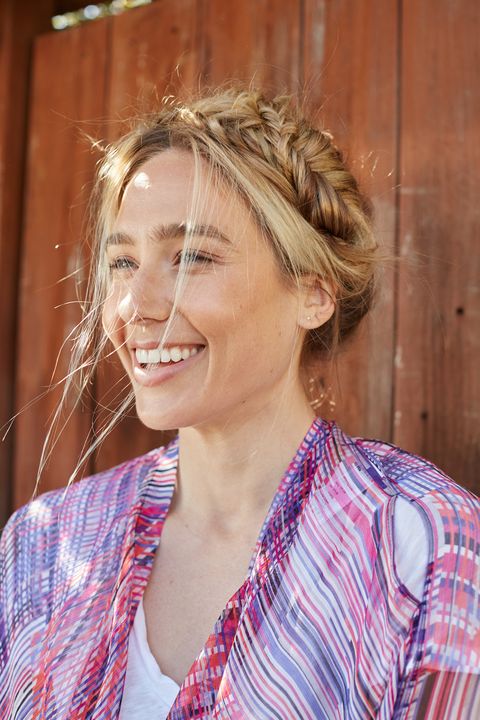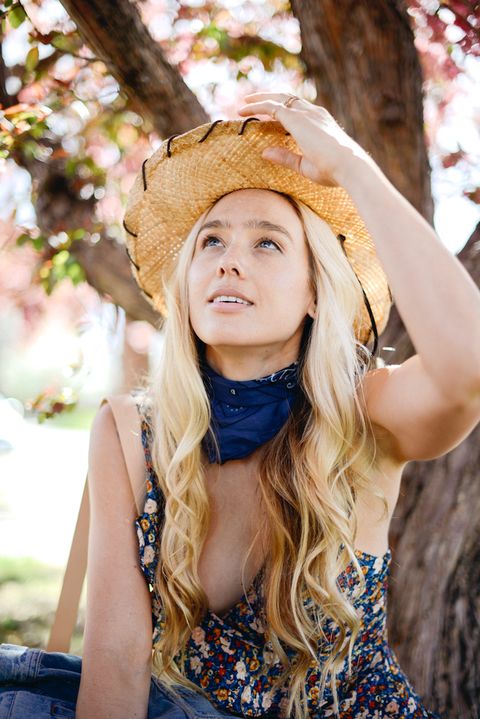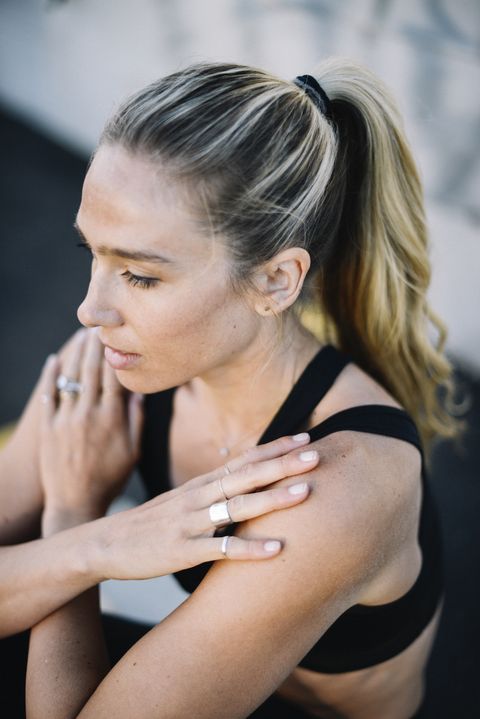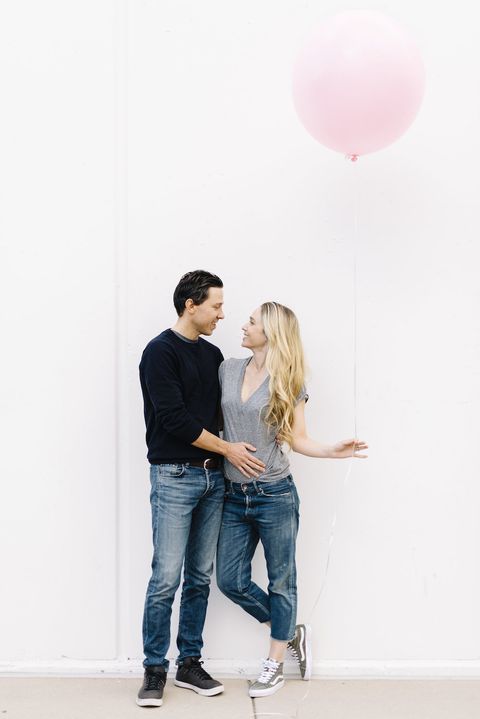
I was 10 weeks pregnant when an ultrasound technician asked how far along I was. “I’m not seeing that here,” she said, staring at the screen where my uterus was projected.
It wasn’t until late 2016, when I was 32 years old and my husband Drew was 39, that we’d stopped using condoms. In December, when we got pregnant, I told my parents, colleagues, close friends, and some training clients. By that point, we’d moved to Denver, Colorado, where our families lived, with baby making on our minds. The fitness streaming site I’d partnered with had shuttered, and my Under Armour contract ended, which meant less of the travel and modeling that had led us to put off parenthood. Meanwhile, I was making about $50,000 a year in Instagram revenue alone and could easily take some time off from teaching NUFit, the high-intensity dance cardio class I’d developed. I figured my personal brand could evolve throughout my pregnancy to address pre- and postnatal fitness. I had a plan.

It’s why, when my doctor came in to discuss the ultrasound and explain that a genetic error in the embryo led me to miscarry, I couldn’t believe what was happening. When I imagined sharing the bad news with the family members, colleagues, and friends I’d already told, a deep dread settled over me.
Three days later, I went in for a 20-minute dilation and curettage (D and C). I felt cramping despite the extra-strength ibuprofen I’d taken, and when I started to tear up, Drew, who was right by my side, reached for my hand.

Afterward, I bawled all the way home. And yet, when I got there, I instagrammed a photo of me smiling broadly with the caption, “You cry a little, and then you wait for the sun to come out,” purposefully avoiding specific references to my miscarriage.
I’d address my real life later—or not. My experience just felt too dark. Besides, I’ve never seen my 65,000 Instagram followers as my closest friends. For me, Instagram is a business, and I’m the talent behind my brand. I had to act like I had my shit together—even though I was falling apart.
Keeping Up the Fitfluencer Facade

Before I knew I’d need my D and C, I had scheduled a photo shoot with a few other female health and fitness entrepreneurs in Los Angeles, so I had to board a flight the day after the procedure. When I arrived on set, my stomach was swollen, my face was pale, and my boobs were huge—a result of lingering pregnancy hormones. I was bleeding heavily, a side effect that would continue for nearly a week. Since tampons aren’t recommended after D and Cs due to the risk of infection, I had to wear a huge pad you could see right through my spandex pants while we took the photos.
“All I wanted to do was go to bed and cry.”
While posing, I focused on keeping my boobs, my stomach, and my backside out of sight, hiding my truth from the camera: All I wanted to do was go to bed and cry.
When I got home several days later, my sadness was so intense, I cancelled my NUFit classes for two weeks. To stop myself from googling reasons why I’d miscarried and stressing about whether I’d be able to have kids, I threw myself into creating content for my website and social media channels.
A Second Chance
Two months after the miscarriage, when Drew and I started trying to get pregnant again, the goal changed our sex life entirely: Hyper-focused on having sex at exactly the right time of month, I tracked my ovulation obsessively, neurotically monitoring my cycle with an over-the-counter kit. As soon as I knew I was ovulating, I’d call Drew to come home from work right away. Sex wasn’t fun for either of us.
Meanwhile, on Instagram, I posted unrelated content daily, keeping my feed on brand with winter skincare tips and abs workouts featuring photos taken before my first pregnancy.
I never felt like I was lying to my followers—I simply wasn’t sharing private information.
I never felt like I was lying to my followers—I simply wasn’t sharing private information. My social following kept growing at a steady pace, but IRL I was at one of my lowest points. I felt isolated and alone.
In May 2017, I took a pregnancy test during a weekend trip to Portland, Oregon, and found out I was pregnant again. I called Drew, who’d stayed back in Denver, to tell him the news right away—and of course he was ecstatic. But the next morning, I noticed cramping that crept from my stomach up the left side of my rib cage and a little blood in my underwear, symptoms my ob-gyn initially chalked up to embryo implantation.
On Sunday, when I boarded my homebound flight, the cramps were so intense that I had to pull the waist of my pants down below my belly to feel a little relief. I looked out the window and prayed we would be OK.

At the airport, I felt some wetness in my underwear and went to check it out in the bathroom. It looked like I’d had the worst period ever.
This time when I called my ob-gyn, the doctor told to get to the emergency room ASAP in case I’d had an ectopic pregnancy, implantation outside of the uterus, which can be life-threatening. I totally freaked out, but tried to stay calm as I drove to the hospital, where Drew met me.
“I was convinced something was wrong with me.”
In the ER, I started bawling. After doctors ran a bunch of tests, they confirmed the embryo had a genetic problem—again. I was convinced something was wrong with me.
When I got home, I posted a selfie from a photo shoot I did a while back, captioning it “OK universe…what else do you got for me this week? You know you’re messing with a girl who never gives up.” Even though none of my followers, who left comments like, “Feeling you” and “You got this,” had any clue what I was talking about, it felt good to post something on brand.
I didn’t even think about Instagramming what had actually happened to me—it just felt too raw. Besides, I had no useful information or advice to provide, so using the forum to discuss my second miscarriage seemed pointless. And I didn’t want trolls asking what was wrong with me and Drew while we mourned.
Getting to the Root of the Issue

In early June, Drew and I went to a fertility clinic to rule out any physiological issues and check my hormone and thyroid levels. I also saw an acupuncturist who specializes in fertility, a therapist, and a nutritionist. All of my appointments made getting pregnant feel like a full-time job.
By the end of the month, after several weeks of testing, my fertility doctor began to suspect I had an under-active thyroid that was affecting my hormone levels and prescribed a drug called levothyroxine. Within one week of taking it, I lost five pounds, woke up with heart palpitations, and began experiencing panic attacks—all known side effects. I had three episodes before the medicine, which I discontinued, left my system.
I still felt like crap from the lingering side effects, depressed about not getting pregnant, and inexplicably tired. Since about 90 percent of my income was coming from sponsored ads on Instagram, I continued to post daily photos but struggled to select images and write captions.
I would sit at my desk and think, “I don’t really give a shit.”
Uninspired, I would sit at my desk and think, “I don’t really give a shit.” I told myself I just had to push through, even if it took longer to come up with ideas that seemed authentic and engaging.
Although I decided to take the summer off, cancelling my NUfit classes and asking my blog manager and photographer to take over for me whenever I didn’t have time to post, I didn’t call on them often, convinced everything I’d worked for would fall apart if I stopped hustling. If a brand wanted to collaborate, I’d organize and style a shoot, doing more than 10 in three months.
Although I posted about “getting through a hard time” to shed a little light on my life, I never elaborated on exactly what I was going through.
A Third Try
In August, my fertility doctor confirmed I had no thyroid issues after all. I had lots of viable eggs, she said, and Drew’s sperm also was fine. We’d spent more than $20,000 on tests but still had no answers.
The next step was in vitro fertilization, which would require five months of medication, including birth control to regulate my cycles, then synthetic hormones to prep my uterus for the embryo implantation. After my panic attacks, I worried about how I’d react to the medication, so Drew and I decided to try conceiving naturally for a bit longer.
When we didn’t get pregnant that September, I planned to start a new pack of birth control on November 1 after an appearance at a yoga and meditation retreat in Aspen, Colorado.
When I got there, though, I felt unusually emotional and exhausted. While watching a movie one night, an intense tired feeling washed over me unlike anything I’d ever experienced. It dawned on me: I was pregnant. The next day, I took a test that confirmed it.

Drew and I were absolutely overjoyed—after everything I’d been through, we wanted this baby so badly!—but I worried our hell would continue if I couldn’t carry the pregnancy to term. It’s why, when I got home, Drew and I barely even talked about it—we just didn’t want to be let down.
Although Instagram was a welcome distraction, I posted nothing about the third pregnancy. If we miscarried, I knew telling my followers what happened would make everything more painful.
Opening Up
When I was 12 weeks pregnant, we told our families, close friends, and my team at NUFit we were having a baby girl. But I still felt torn about sharing the news on Instagram: Sure, it would help me connect with my mom-to-be followers, but I knew what it felt like to see a pregnancy announcement on social media and feel so empty inside. Besides, my miscarriages had made me so paranoid that it felt easier to avoid discussing it altogether.
When I hit the 15-week mark in January, almost one year after our first miscarriage, Drew and I decided it was time to share our news—but not without acknowledging the women who were struggling to conceive or carry to term.

I knew I had to address my two miscarriages, and with a happy ending on the horizon, I actually felt like sharing. My sad story finally had a purpose: to help people going through the same thing. There was so much I wanted to share with readers about my acupuncture, fertility treatment testing, what I ate, and how therapy helped me.
I spent an hour composing a pregnancy announcement. When I hit “post,” I felt like a weight had been lifted off my shoulders. It was like I’d finally come clean.
I was glued to my phone screen the rest of the day as thousands of likes and comments rolled in. Most of them contained some version of, “Congrats!” and, “So happy for you!” while others related to my repeat pregnancy loss and said my story gave them hope. At the same time, some people suggested I’d miscarried because I was skinny or I’d worked out. The haters make me feel better about having kept my personal life private in the first place.
Forty-one weeks and two days into my pregnancy, on July 17, 2018, Drew and I welcomed our baby girl Skyler Shea Pozatek into the world. When the nurses placed her in my arms after almost nine hours of labor, I shook uncontrollably, crying as I looked at her with awe and held her tight. After all the pain and years of trying to conceive, we’d made it through.
View this post on Instagram
Teepee time is our favorite time ⛺️ Sky and I love hanging in her teepee, I always wanted one as a kid so seeing my daughter love it as much as me makes me so happy. Also, I want to send ? to all the new mamas out there! You rock. Xx Nat #postpartum #mama #NUFit
A post shared by N a t a l i e U h l i n g (@natalieuhling) on
Source: Read Full Article
